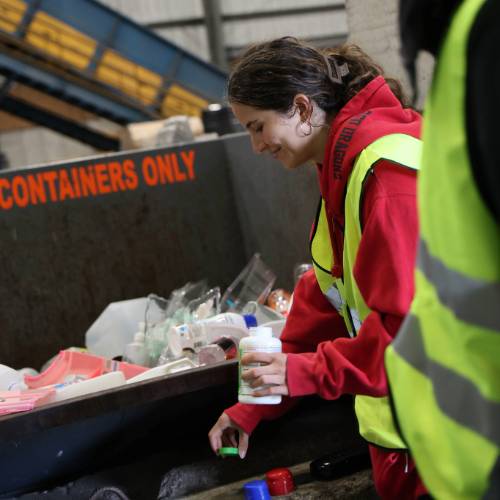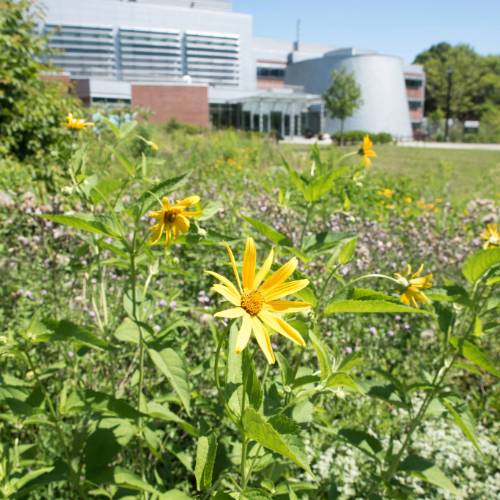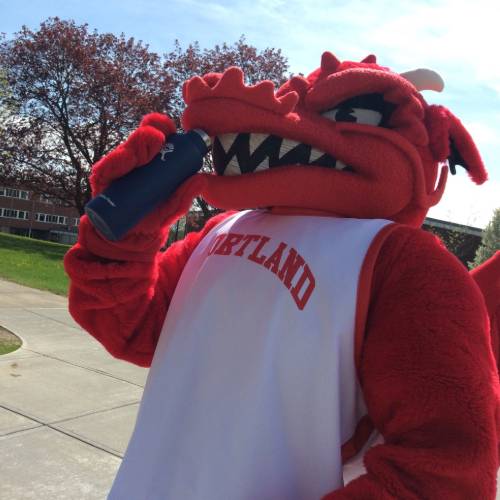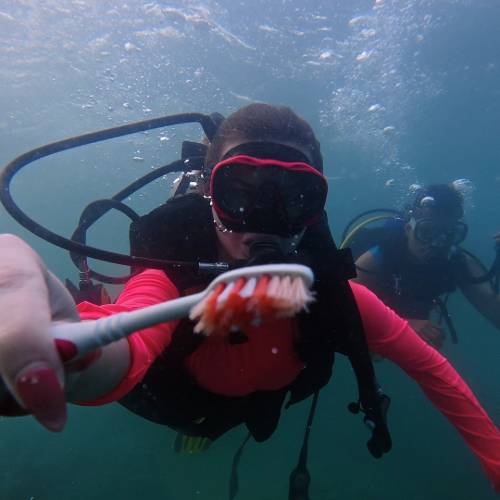
11/21/2025
As the Green Reps celebrate their first full year back at SUNY Cortland, the students reflect on their experiences working on campus and other sustainability related topics near and dear to them. Below are articles from each Green Rep answering the big question: "What would you like everyone at SUNY Cortland to know?"
Coral reefs: why we must save them, before it’s too late
By Luna Demski
A lot of people think of corals only as pretty, colorful looking underwater structures and nothing more, but these structures are essential for our planet. Coral reefs take up less than 1% of Earth’s surface but provide a home to 25% of marine species, including fish, turtles, dolphins, whales and manta rays. They offer not only a diverse food source for those animals, but also shelter, resting, and breeding places. Coral reefs benefit animals and are essential to humans. Almost 1 billion people depend on healthy coral reef ecosystems. People who live near coastal regions rely on them for fishing, tourism or other marine industries, offering thousands of jobs worldwide ¹. Additionally, coral reefs protect the shoreline by reducing the impact of waves and natural disasters like storms, floods, tsunamis, and hurricanes. So, they also prevent loss of life, property damage, and erosion ². The ocean, including coral reefs, is also known as the rainforests of the sea, because it has absorbed 93% of extra heat from greenhouse gasses ³. 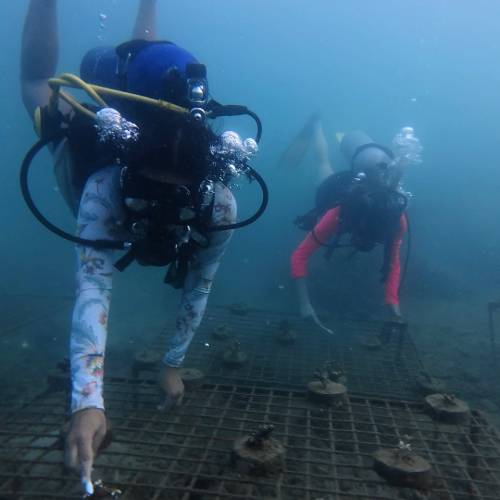
But there are also big threats to corals that may lead to the end of these incredible and beneficial creatures. Stressors like climate change, destructive fishing methods, such as dynamite fishing and ocean pollution, affect the ocean and its coral diversity long-term ⁴. Between 2014 and 2017, 75% of corals suffered or died from heat stress through climate change. Research predicts that if nothing changes, 75% of all corals could die by 2050. Coral bleaching is a widely spread phenomena among corals. Algae lives symbiotically with corals, helping with nutrients exchange. When our ocean temperatures rise, the algae produces toxins harming the coral. This causes the coral to expel their companions and lose their color. But this also means, that without these algae, corals lose most of their food source and begin to perish ³. Future coral bleaching of corals would not only cost billions of dollars due to losses in tourism, damage from floods and other natural disasters, but would also destroy crucial habitats for many marine species ³.
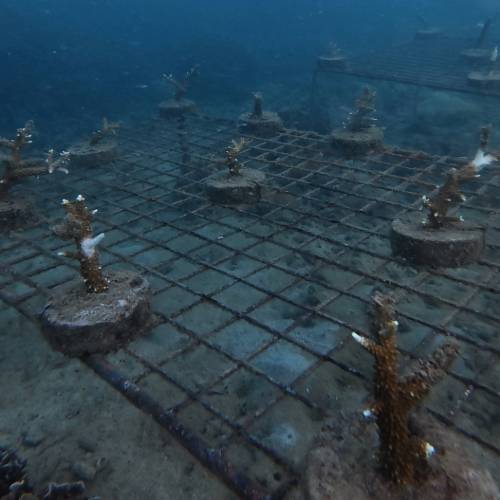 To protect the coral, humans have built coral reef restoration systems to increase coral resilience and let them recover naturally from environmental pressures ⁴. I had the incredible opportunity to volunteer and help maintain a coral reef restoration in the Philippines earlier this year. I helped a small independent diving school; who’s main heartfelt mission was the coral restoration. They focus to build metal structures and plant little healthy coral branches in concrete plugs, so the corals can naturally grow over them to form a new reef in the long term. The structure required high maintenance, as we had to dive almost every day down to the 3-7 meters (10-23 feet) deep structures, to scrub off the algae with small brushes, to prevent the algae from interfering with the coral’s nutrient intake. During my time I learned a lot about coral reefs and why we should protect them if we still can. There is no replacement for coral reefs on our planet. I recommend everyone volunteer in a coral reef restoration project to experience the anthropogenic impact firsthand and to see how even a single person can have a small but meaningful impact on the environment. Even if you don’t get the chance to volunteer you can still make changes in your behavior to prevent the coral reef from dying completely. Like using coral-friendly sunscreen, minimizing your carbon footprint, making environmentally conscious purchasing decisions or donating to programs that care for the health of the underwater biome ⁵.
To protect the coral, humans have built coral reef restoration systems to increase coral resilience and let them recover naturally from environmental pressures ⁴. I had the incredible opportunity to volunteer and help maintain a coral reef restoration in the Philippines earlier this year. I helped a small independent diving school; who’s main heartfelt mission was the coral restoration. They focus to build metal structures and plant little healthy coral branches in concrete plugs, so the corals can naturally grow over them to form a new reef in the long term. The structure required high maintenance, as we had to dive almost every day down to the 3-7 meters (10-23 feet) deep structures, to scrub off the algae with small brushes, to prevent the algae from interfering with the coral’s nutrient intake. During my time I learned a lot about coral reefs and why we should protect them if we still can. There is no replacement for coral reefs on our planet. I recommend everyone volunteer in a coral reef restoration project to experience the anthropogenic impact firsthand and to see how even a single person can have a small but meaningful impact on the environment. Even if you don’t get the chance to volunteer you can still make changes in your behavior to prevent the coral reef from dying completely. Like using coral-friendly sunscreen, minimizing your carbon footprint, making environmentally conscious purchasing decisions or donating to programs that care for the health of the underwater biome ⁵.
Together through conscious choices and collective action, we can support recovery of coral reefs and ensure that their colorful ecosystem continues to thrive long into the future.
Sources:
- Why we need coral reefs. (2025, June 20) Great Barrier Reef Foundation. https://www.barrierreef.org/news/news/why-we-need-coral-reefs
- NOAA National Ocean Service Education: Corals Tutorial. https://oceanservice.noaa.gov/education/tutorial_corals/coral07_importance.html
- Chasing Corals – The Issues https://chasingcoral.com/the-issue/
- Coral Restoration Foundation. (2025, April 7). Why it Matters: Coral Restoration. Coral Restoration Foundation. https://coralrestoration.org/why-it-matters-coral-restoration/
- Cottrell. (2019, June 7). Coral reefs and climate change. WWF. https://www.wwf.org.uk/coral-reefs-and-climate-change
A visit to the Cortland recycling facility
By Ava Brandon 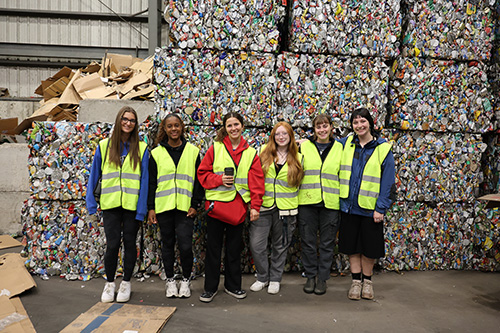
Earlier this semester, I had the opportunity to visit the Cortland recycling facility with my fellow Green Reps, and the experience completely changed how I view recycling. Before going, I thought recycling was just about tossing bottles, cans, and cardboard into the right bin and feeling good about helping the planet. Once we arrived, I quickly realized how much work actually goes into sorting and cleaning everything that people throw away. The workers explained how recycling only works well when people take the time to do it correctly, and that most contamination starts with simple mistakes made at home, or in Resident Halls and classrooms on campus.
Walking through the facility, I watched workers carefully separate different materials by hand while large machines sorted plastics and metals. It was surprising to see how one dirty container or a few plastic bags could ruin an entire batch of recyclables. The staff said that when this happens, the contaminated materials must be thrown away, which wastes both time and resources. They also showed us what happens to the items that are recycled correctly, explaining how they are cleaned, processed, and sent to be made into new products. It made me realize that recycling is part of a larger cycle that depends on everyone doing their part.
After seeing all the effort that goes into the process, I have been much more careful about how I recycle on campus. I rinse out containers, flatten cardboard boxes, and double-check what materials can actually go in the bins. I have also talked with my friends and Green Reps about what we learned, since many people still do not know that certain items like plastic bags or greasy pizza boxes cannot be recycled.
The visit showed me that recycling is not just about separating trash but about respecting the hard work of the people who keep the system running. It also reminded me that when students take the time to recycle properly, we help reduce pollution, save energy, and protect the environment right here in our own community.
Mind the gap
By Fiona Joss
Mind the gap, then mend it.
I threaded my first needle at the age of 7. My best friend's grandmother taught me to sew during a playdate, and I’ve been fascinated with it ever since. The near-endless possibilities, skills, and applications make it something that, for me, could never be mundane. I love creating with textiles, even if the process is often slow, difficult, or tedious. Through this hobby, I’ve gained an uncommon respect for my clothes, as I recognize the skills needed to craft these items.
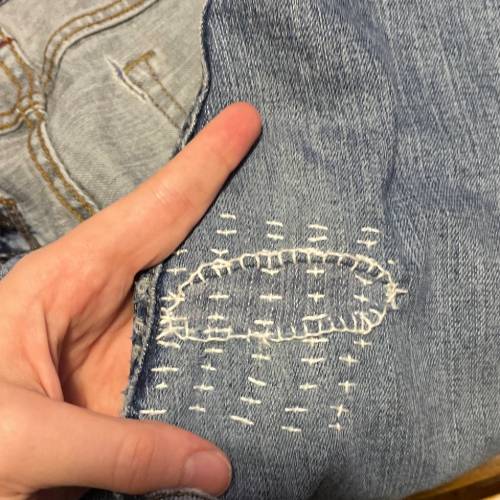
Unfortunately, there is a modern ideology that views clothes as disposable. It has become socially acceptable to buy something, wear it once, and then discard it. The slightest signs of wear or imperfection can mean the difference between life and death for a garment. Since fast fashion emerged in the 1990s, the rapid and inexpensive methods that have flooded the market have led to a decline in the overall quality and durability of textile products. According to Earth.org, 100 billion garments are produced each year, and of that, 92 million tons end up in landfills. Textile production is one of the most polluting industries in the world, with more than half of all textiles globally being made of polyester, a spun plastic. All these items are still on the planet, and will continue to be for a very, very long time.
To combat my own overconsumption, I’m learning to mend my clothes. I’ve been trying my hand at Sashiko stitch mending for the last few years. Sashiko is a traditional Japanese technique that uses running stitches to repair textiles, creating a decorative and durable mend. While my technique is far from perfect or traditional, it has altered my perspective on clothing. After numerous repairs, patches, and reinforcements to the stretched and worn fibers, I’ve come to think of it as a way to show gratitude for the stress these items endure. With proper care and attention, they can last, and with creativity, they can serve a purpose beyond their original intent.
Why I decided to be a Green Rep
By Tiana Schelble 
When I was in high school, right on the verge of graduating, I started to search for jobs in college. While scrolling through job postings, the Green Reps program caught my eye. I've always been passionate about conservation and sustainability on a global level. Furthermore, the essence of my college essay revolved around these topics. This job seemed like a perfect fit along with being a great gateway for my future career as a foreign correspondent focusing on stories involving the environment and animal rights.
Through this job I have been able to get a deeper understanding of the components SUNY Cortland uses to promote sustainable habits. I was extremely impressed when I found out that the waste in the buffet style dining halls is composted. Recently, we have brought in can recycling into the dorm building so that students can properly dispose of any can.
We all live on this planet together, and one action affects us all. I am convinced that more students will care about sustainable habits if they truly understand the damage they are inflicting upon our planet. Through our Instagram page we post multiple times a month promoting green habits and information in a fun and accessible way. In the background, we work on new ways and ideas within Cortland to limit waste. In Resident Halls and across campus we host multiple events a month for students to attend on an educational aspect.
I’m so grateful for this job, especially when I see student participation and I am given opportunities to educate the student body.
Government shutdowns impact on the National Park Service
By Caroline Rossi 
Government shutdowns occur when the federal government cannot agree on a budget for federal agencies and programs. In the United States, these shutdowns result in our National Parks closing or greatly reducing services. The implications of the National Parks cutbacks impact culture, economies, the environment, and people. Closed parks and their staff become subject to uncertainty, safety concerns, and damage.
On the surface, the majority of park staff are furloughed, people lose their forms of income and, in some cases, housing. People become displaced and their jobs are not fulfilled. Within the parks, the lack of staffing reduces public access to amenities such as bathrooms, campground amenities, and visitor centers. Safety also becomes a greater concern as search-and-rescue teams become short-staffed or non-existent. These consequences result in parks becoming dirty, unkept, and visitors are left at a higher risk in cases of accidents.
The economic impact of the NPS affects local economies, including local businesses, and a subsequent loss of tax revenue. The NPS also supports over 400,000 jobs across the country, through recreation, fire and rescue teams, as well as countless supporting and seasonal roles. Additionally, the inability to collect entrance fees to places that rely on visitors has the potential to impact local communities and larger economies.
With few people working and visiting the parks, it may sound like a chance for the environment to thrive. In reality, most of the lands are managed; professionals must work hard to remove invasive species, protect wildlife, and preserve natural and historic assets.
Government shutdowns have far-reaching and poignant consequences that can have long-lasting effects on our National Parks. During this time, supporters of the NSP can take action by contacting members of Congress and expressing the urgency of the issue, volunteering in parks, donating to causes such as the National Park Foundation, Parks Project, etc., and becoming educated on the issue. The parks belong to all of us, and understanding the effects of decisions made by the government that impact the health and safety of these areas is crucial in keeping the parks pristine and open to the public.
Sustainable architecture on Cortland campus
By Nuala Seabrook
Have you ever heard of a bioswale? If not, did you know you probably walk by one everyday campus?
Bioswales are vegetated shallow trenches designed to manage stormwater runoff by collecting, filtering, and infiltrating it into the ground. On Cortland Campus, there are two, one located outside Bowers Hall, and one located outside the Student Life Center, close to the Outdoor Pursuits section of the building.
The ditches are filled with plants, soil, and rocks, that are used to slow down and clean water from surfaces like roads, parking lots, and sidewalks before it reaches storm drains or streams. This process can reduce flooding, recharge groundwater, and improve water quality by filtering out pollutants like oil and fertilizer. 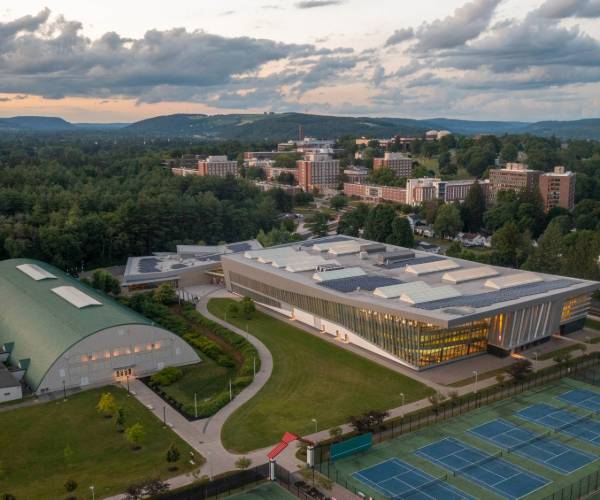
In addition, the SLC also features a partial green roof, planted with sod to reduce the building’s environmental impacts, and photovoltaic panels to capture some of the sun’s energy and reduce energy expenses. Green roofs improve the building’s drainage system, much like the bioswales, and boost thermal performance. Photovoltaic panels balance strategies for heat rejection to ensure thermal comfort. The sloping, self-shading element of these window shutters decreases electricity usage by using the sun as its main source of heat for the building.
There are many elements of several buildings on campus that reflect a sustainable mindset in campus planning. For more information, visit the sustainability page on the Cortland website, or ask a Green Rep!
Climate change and the impacts it has on New York state snowfall
By Kat Wilburn 
Climate change is transforming New York in dramatic ways, with average temperatures rising drastically and winters warming much faster than summers. This ongoing warming has led to more frequent and intense rainfall, shorter snow seasons, and a noticeable increase in flooding and stormwater pollution across the state. As ocean waters warm and sea levels rise, already more than a foot since 1900 New York’s coastal regions face ever-stronger impacts from tidal flooding and destructive storm surges. For college students in Cortland, these changes impact ecosystem diversity, agriculture, recreational opportunities, and the state’s tourism economy, highlighting the interconnected nature of climate science and public life.
Extreme weather events, such as longer heat waves and heavier precipitation, are projected to become even more common in the coming decades. This puts particular stress on urban centers, infrastructure, and vulnerable communities, amplifying social inequities and environmental risks. Addressing climate change will require rapid reductions in greenhouse gas emissions as well as robust investment in adaptation to protect public health, support environmental justice, and secure New York’s future against rising seas and evolving climate hazards. Students at SUNY Cortland are part of the generation tasked with advancing research, advocacy, and sustainable solutions for a resilient New York.
Citations
- New York State Department of Environmental Conservation. (2025). Climate change effects and impacts. https://dec.ny.gov/environmental-protection/climate-change/effects-impacts
- Mayor’s Office, City of New York. (2025, September). City of New York takes multiple actions supporting challenges to climate change. https://www.nyc.gov/mayors-office/news/2025/09/city-of-new-york-takes-multiple-actions-supporting-challenges-to
- Earthjustice. (2025, October 26). NY Supreme Court rules the state must issue climate regulations. https://earthjustice.org/press/2025/ny-supreme-court-rules-the-state-must-issue-climate-regulations
Why reusable? Reasons why opting for reusable items is the better decision
By Brianne Leak
Health benefits of reusable products over single use
Using reusable products offers several important health benefits compared to single-use items. Reusables, especially those made from stainless steel, glass, or BPA-free materials, help reduce exposure to harmful chemicals that can leach from disposable plastics. A study conducted by the State University of New York of Fredonia revealed that 93% of the plastic bottled waters tested contained harmful chemicals and microplastics. Only 17 out of the 259 samples contained no microplastics, while one bottle of a popular plastic bottle company had concentrations as high as 10,000 plastic pieces per liter. Reusable bottles also promote healthier habits, such as staying hydrated when using a reusable water bottle or reducing contact with potentially contaminated single-use items. Choosing durable, safe materials and reusable products contributes to overall well-being by lowering toxin exposure and encouraging more mindful, health-focused daily routines.
Environmental benefits of reusable products over single use
Using reusable water bottles significantly reduces the environmental damage caused by single-use plastics. Disposable plastic bottles require large amounts of water, energy, and oil to produce, and most end up in landfills, oceans, or incinerators, where they pollute the air and contribute to long-lasting ecological harm. Plastic can take more than 450 years to break down, releasing microplastic that contaminate soil, waterways, and marine life. Because only a small fraction of plastic bottles is recycled, switching to reusable containers lowers plastic waste at its source, decreases pollution, and helps protect ecosystems and wildlife.
Single use plastic production effects
For every single-use plastic bottle of water created, three times the amount of water in the bottle is used to create it. It requires almost 2,000 times more energy to manufacture a bottle of water than it does to produce tap water, according to the Pacific Institute. If you fill a bottle of water a quarter full, that is about as much oil as it took to produce it. Plastic single-use water bottles sales increased 93% between 2010 and 2020. SUNY Cortland students should aim to decrease these sales instead of being part of the increase.
Citations
- https://www.seagoinggreen.org/blog/why-are-reusable-water-bottles-good-for-the-environment
- https://www.cnn.com/2023/03/16/world/plastic-water-bottles-un-report-climate
